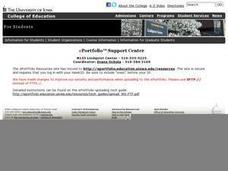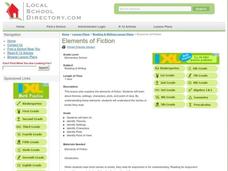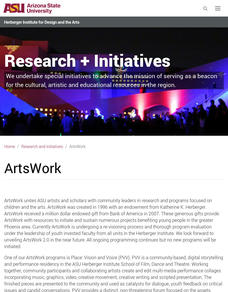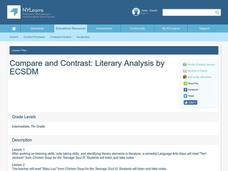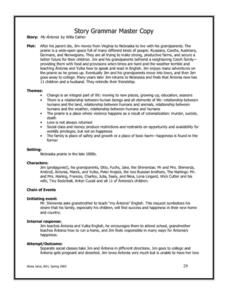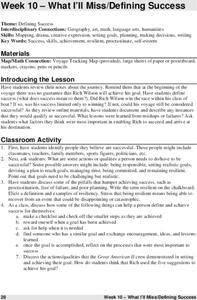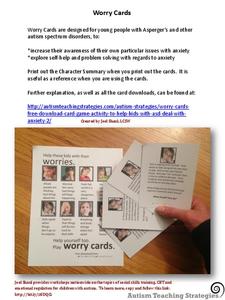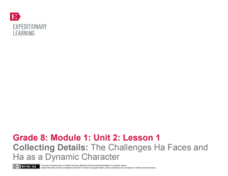Curated OER
Dr. Seuss For a Day
Second graders brainstorm words to describe Thing One and Thing Two characters from Dr. Seuss computer program, use variety of adjectives to create descriptions, and create new set of characters, Thing Three and Thing Four, by drawing...
Curated OER
Flight of the Imagination
Students study the success of video games by reading an online article. They work in groups to design settings, storylines, characters and technical features for their own fantasy video games. Finally, they write scripts for previews of...
Curated OER
Comprehension-Characters/characterization
Fifth graders discuss characterization as well as to define antagonist and protagonist. In this language arts lesson plan, 5th graders write questions for an interview of a character in the book "The Three Little Pigs" and then answer...
Curated OER
Introduction to Little House Books
Third graders identify the main characters in the Ingalls family and describe the relationships between the characters. They locate the setting of the book on a map of the Upper Mid- West. Students understand that the books are set in...
Curated OER
Elements of Fiction
Students identify key story elements in a fiction text. In this literacy lesson, students are introduced to the various elements of fiction such as the setting, plot, and theme. Students read a short story of their choice and identify...
Curated OER
Setting the Stage from the Page
Students examine the differences between the portrayal of characters in books and in motion pictures. Using the novel, The Kite Runner, students discuss the ways in which the characters can be interpreted. Students create original...
Curated OER
Michelle Kwan: Heart of a Champion
Who is a champion to your class? Elementary and middle schoolers think of a role-model from their lives. Then, in their journals, they write evidence of that person's perseverance. They identify the character trait of perseverance with...
Curated OER
Creating Plays from Children's Stories
Students explain how individual elements (e.g., plot, theme, character, conflict, etc.) comprise the structure of a play. They write an original one-act play with developed characters, specific setting, conflict, and resolution.
Curated OER
Compare and Contrast: Literary Analysis
Seventh graders are able to use active listening skills, take notes and identify literary elements of a short story. They use/create graphic organizer, compare/contrast literary elements from various stories and compare and contrast traits.
Curated OER
Character Traits
Sixth graders explore details from a story to develop ideas and opinions about character traits. Using a Smart Board, 6th graders create a chart explaining the character's action and traits. In groups, students discuss and describe...
Curated OER
Character Traits
Using a three-column chart labeled "Character," "Action," and "Trait," pupils analyze the traits of several characters from a short story. The lesson is designed for a SMART board, but a teacher could easily do the lesson without the...
Curated OER
Character Sketches
Students are introduced to the types of characters found in short stories. They read a short story in class and produce sketches of the protagonist and antagonist. Finally, they create their own characters and write about them in their...
Curated OER
Prince Ibrahima
Sixth graders read and utilize the facts from the story "Abd al-Rahmen Ibrahima" by Walter Dean Myers to analyze the main character's life which is ruined by conflict, jealousy, and greed. Journal entries are created in response to the...
Curated OER
Character Baseball Cards
Create baseball cards for literary characters with this lesson plan. It introduces students to baseball cards, their components (stats, picture, etc.), and prompts them to draft and publish their own cards based on figures from...
Curated OER
My Antonia: Story Grammar
Pupils can write down all of the major plot elements of My Antonia by Willa Cather on this straightforward worksheet. Learners note down themes, characters, the chain of events, and more.
Curated OER
Reading Fiction - Character
The goal of this lesson is to have learners understand how character is created through a combination of what they say and do, and what others say about them. In pairs, learners construct a short dialogue between a parent and child after...
Curated OER
Defining Success
The class defines what it means to be successful by examining the achievements of Rich Wilson. They create headlines for a mock paper, discuss achieving personal goals, and create a scrapbook of his journey. Tip: Use this resource when...
Curated OER
Character Traits - Who are We?
Sixth graders examine character traits. In this character education lesson, 6th graders set goals to strengthen particular personal character traits. Students watch their instructor model the character trait journaling strategy prior to...
Tellagami Labs
Tellagami
Bring the world of video messaging into your classroom with this creative communication application. Offering the ability to create animations with customized characters, backgrounds, and recorded messages, this resource is guaranteed to...
Curated OER
Worry Cards
Help learners on the autism spectrum build awareness of their feelings of anxiety through a hands-on learning activity. Using a set of cards with examples of the different types of anxiety someone might face, learners discuss ideas of...
EngageNY
Collecting Details: The Challenges Ha Faces and Ha as a Dynamic Character
What is a dynamic character? Using an interesting resource, scholars set out to answer the question. They create graphic organizers to collect details about character development as they read the novel Inside Out & Back Again. They...
Curated OER
Historical Agency in History Book Sets (HBS)
Study historical events by combining the study of historical fiction and non-fiction. Learners read about true past events in historical fiction novels and then research non-fiction accounts of the same events. What are some differences...
Have Fun Teaching
Silly Stories
Young writers get a jump start on story telling by selecting a plot, a setting, and multiple character cards and then use these basic elements to create a tale.
Curated OER
The "Write" Stuff: Strategies and Conventions for Imaginative Writing
Fifth graders develop and practice the steps involved in imaginative writing. They follow the steps/worksheets included and write imaginative stories of their own.
Other popular searches
- Characters and Setting
- Main Characters and Setting
- Plot, Characters and Setting
- Main Character and Setting
- Story Characters and Setting
- Plot Characters and Setting
- Characters & Setting
- Plot Setting Characters
- Characters \& Setting
- Characters Setting





